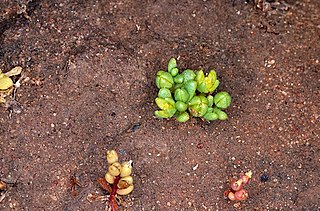Patersonia maxwellii is a species of flowering plant in the iris family Iridaceae and is endemic to the south of Western Australia. It is a tufted, rhizome-forming perennial herb with linear leaves and violet tepals.

Eucalyptus drummondii, commonly known as Drummond's gum or Drummond's mallee, is a species of mallee or tree that is endemic to the southwest of Western Australia. It has smooth bark, narrow elliptical to egg-shaped adult leaves, flower buds in groups of seven, white flowers and hemispherical fruit.

Grevillea acuaria is a species of flowering plant in the family Proteaceae and is endemic to the south-west of Western Australia. It is a rounded, bushy to erect shrub with spreading linear to narrowly elliptic leaves and red flowers arranged in small clusters.

Lasiopetalum floribundum, commonly known as free flowering lasiopetalum, is a species of flowering plant in the family Malvaceae and is endemic to the south-west of Western Australia. It is an erect or spreading shrub with hairy young stems, egg-shaped leaves and pale pink, mauve or white flowers.

Persoonia angustiflora is a species of flowering plant in the family Proteaceae and is endemic to the south-west of Western Australia. It is an erect shrub with hairy branches and leaves, linear, more or less cylindrical leaves and yellow or greenish yellow flowers arranged singly or in groups of up to four.

Gunniopsis septifraga, commonly known as green pigface, is a species of flowering plant in the iceplant family, Aizoaceae and is endemic to Australia. It is a prostrate to tuft-forming annual herb, with oblong to lance-shaped leaves and small greenish flowers, that grows around salt lakes.

Goodenia arthrotricha is a species of flowering plant in the family Goodeniaceae and endemic to south-western Western Australia. It is an erect perennial, herb with linear to lance-shaped leaves with the narrower end towards the base, racemes of blue flowers with linear bracteoles at the base, and oval fruit.
Goodenia leptoclada, commonly known as thin-stemmed goodenia, is a species of flowering plant in the family Goodeniaceae and is endemic to the extreme south-west of Western Australia. It is an ascending perennial herb with lance-shaped to egg-shaped leaves with the narrower end towards the base and racemes of blue flowers.
Patersonia argyrea is a species of plant in the iris family Iridaceae and is endemic to Western Australia. It is a tufted perennial herb with linear, sword-shaped leaves and violet tepals.

Patersonia babianoides is a species of plant in the iris family Iridaceae and is endemic to the south-west of Western Australia. It is a tufted, rhizome-forming herb with soft, linear to elliptic leaves and blue-violet tepals on a relatively short flowering scape.

Patersonia graminea, commonly known as grass-leaved patersonia, is a species of plant in the iris family Iridaceae and is endemic to the south-west of Western Australia. It is a clump-forming herb with linear, grass-like leaves and pale violet tepals.
Patersonia inaequalis, commonly known as unequal bract patersonia, is a species of plant in the iris family Iridaceae and is endemic to a restricted part of the south-west of Western Australia. It is a tufted herb with linear, often twisted leaves and white tepals.
Patersonia juncea, commonly known as rush leaved patersonia, is a species of plant in the iris family Iridaceae and is endemic to a restricted part of the south-west of Western Australia. It is a tufted perennial herb with linear leaves and pale violet tepals.
Patersonia limbata is a species of plant in the iris family Iridaceae and is endemic to the south of Western Australia. It is a tufted, rhizome-forming herb with sword-shaped, bordered leaves and violet tepals.

Patersonia macrantha is a species of plant in the iris family Iridaceae and is endemic to the northern part of the Northern Territory. It is a tuft-forming herb with linear to sword-shaped leaves and pale violet tepals.
Patersonia pygmaea is a species of plant in the iris family Iridaceae and is endemic to the south-west of Western Australia. It is a tufted, rhizome-forming perennial herb with sword-shaped leaves and bluish-violet to purple tepals.
Patersonia rudis, commonly known as hairy flag, is a species of plant in the iris family Iridaceae and is endemic to the south-west of Western Australia. It is a tufted, rhizome-forming perennial herb with linear to sword-shaped leaves and violet tepals.

Patersonia umbrosa, commonly known as yellow flags, is a species of plant in the iris family Iridaceae and is endemic to the south-west of Western Australia. It is a loosely-tufted, rhizome-forming, perennial herb with linear to sword-shaped leaves and deep bluish-violet or bright yellow tepals.

Lasiopetalum drummondii is a species of flowering plant in the family Malvaceae and is endemic to the south-west of Western Australia. It is an erect, slender shrub with many densely hairy stems, egg-shaped or oblong leaves and white, pink and red flowers.

Mirbelia floribunda, commonly known as purple mirbelia, is a species of flowering plant in the family Fabaceae and is endemic to the south-west of Western Australia. It is an erect, slender or straggling, much-branched shrub with narrowly linear leaves and bluish-purple flowers.












